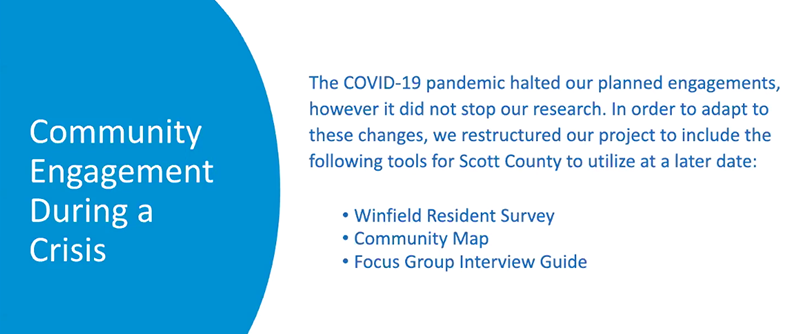On March 11, with the threat from COVID-19 intensifying, University of Minnesota President Joan Gabel ordered the suspension of in-person classes and required that all instruction be moved online. The order included field experiences and in-person activities for community-engaged research projects, such as those facilitated by the Resilient Communities Project. As a result, we immediately began working with our community, student, and faculty partners to identify the best way to move projects forward while adapting to the new realities of physical distancing.
We created a project impact questionnaire that helped us to quickly assess the degree to which each project would need to be adapted. For some projects, the impact was minimal. Students working on a land use planning project in Scott County had visited their site and met in person with their project lead and community stakeholders several times prior to the order. For another project with the League of Minnesota Cities focused on addressing the opioid epidemic, students had already conducted their outreach and interviews and had moved on to the analysis phase of their research, which could easily be accomplished remotely.
However, a project with Scott County Public Health focused on community-identified solutions to increase opportunities for physical activity relied on conducting in-person, place-based engagement in a townhome neighborhood in the city of Savage. When the order was instituted, the students were still formulating their engagement plan and were just beginning to move to implementation.
Through conversation with their Scott County project lead, Lindsay Nelson, and with the guidance of their Humphrey School of Public Affairs capstone instructor, LisaBeth Barajas, the group of four students was able to both shift some of their engagement strategies and create plans for future outreach and engagement by County staff by creating place-based community engagement guides. Ultimately, the students partnered with the townhome property managers to develop and administer a paper survey that could be distributed to residents, created a community asset map that identified barriers to and facilitators of active living near the townhomes and that could be used in future engagement activities, and designed a focus group guide to facilitate future discussions with groups of residents.
“The larger question of how to engage the community during a crisis emerged throughout this project, and unfortunately remains unanswered,” said Sydney Hobart, the student team lead and graduating Master of Public Policy and Master of Public Health student.
According to Lindsay Nelson, who is the County’s Statewide Health Improvement Partnership (SHIP) Coordinator, the pandemic has impacted the public health department in many ways, including how the agency connects with the community. “Because of the pandemic, we are unfortunately not able to meet people where they are at, in person to address various barriers related to health,” she said. In addition, many projects have shifted based on priorities related to addressing the impact of COVID-19, and the department is in the process of accommodating new needs. “Though our work looks different, our focus on the health of our community stays the same,” said Nelson.
As the students continued their work, they reported that property management and potential community partners were excited to speak with them as their schedules allowed. They also received a strong response to their written survey. According to Hobart, “This shows us that there is great interest in this project, even during this time, which will help to sustain future efforts. It may be the case that the stay-at-home order has encouraged residents to become more involved in their community to effect the changes they would like to see in the neighborhood.”
Community engagement may look different for a while or even permanently, but this group agrees that it is crucial to ensure engagement takes place to meet the needs of residents. Virtual settings provide an opportunity for people to connect easily and over great distance, but they may not allow for the same level of authenticity that an in-person conversation would. Virtual technology also may not be as accessible for low-wealth individuals, meaning these populations may continue to be excluded from community engagement initiatives. As a result, governments need to diversify their means of engagement to reach traditionally marginalized communities through other means.
This health equity project touched on many different priorities related to public health in Scott County and fits into the work the County is planning to move forward.
“My hope is that we can support the townhome community in safe, physical activity opportunities, as well as plan for future infrastructure and equipment changes once we are able to safely be around one another again," said Nelson. "We also plan to utilize what the students created in other communities to start the process of engagement around place-based physical activity opportunities.”
The students’ final report and presentation are available on the RCP website.
Special thanks to the project team for their collaboration:
- Lindsay Nelson, Scott County Statewide Health Improvement Partnership (SHIP) Coordinator
- LisaBeth Barajas, Instructor for PA 8081: Public Enagement Capstone
- Sydney Hobart, RCP Student, Humphrey School of Public Affairs & School of Public Health
- Alexandria Grimes, RCP Student, Humphrey School of Public Affairs
- Faiza Mahamud, RCP Student, Humphrey School of Public Affairs
- LaLinda Xiong, RCP Student, Humphrey School of Public Affairs
